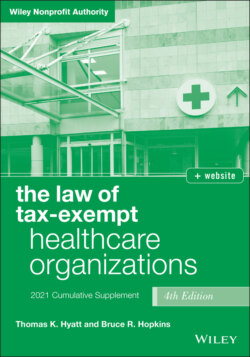Читать книгу The Law of Tax-Exempt Healthcare Organizations - Bruce Hopkins R., Bruce R. Hopkins, David Middlebrook - Страница 15
ОглавлениеCHAPTER FIVE Public Charities and Private Foundations
§ 5.1 Public Institutions
§ 5.6 Recognition of Change in Public Charity Status
§ 5.1 PUBLIC INSTITUTIONS
p. 139, first complete paragraph, fifth line. Insert following footnote number:
agricultural research organizations;17.1
p. 139. Insert following first complete paragraph, before heading:
Qualification for the status of these types of public institutions has historically (for decades) hinged on a primary purpose test, with one exception, namely, the categories of healthcare provider and medical research organizations,18.1 this test is stated in the tax regulations, rather than in the statute. For example, the tax regulations provide that, for an entity to qualify as a school (including a college or university), it must have as its primary function the presentation of formal instruction.18.2 The regulations also provide that an organization may not achieve status as a tax‐exempt operating institution where it is engaged in both educational and non‐educational activities, unless the latter activities are merely incidental to the former.18.3
A court, however, upended the foregoing requirements for qualification as an educational institution (and most other categories of public institutions), holding that the primary‐function test and the merely‐incidental test, as a matter of statutory construction, “exceed the bounds of authority” provided by the statute and thus are unlawful.18.4 The court based this finding on its conclusion that Congress “unambiguously chose not to include a primary‐function requirement in” the statutory definition of educational organization.18.5 That conclusion was, in turn, based on the fact that the “equivalent of that very requirement”18.6 appears in the tax law concerning public charity hospitals.18.7 The heart of this part of the analysis is the statutory construction rule that, in determining whether statutory language is plain and unambiguous, a court must read all parts of the statute together and give full effect to each part.18.8 The court might have come to a different decision if it applied another construction rule, which is that the judicial interpreter is to consider the entire text, in view of its structure and of the physical and logical relation of its many parts.18.9 The problem is that this decision interprets the law of public charities in a way that enables an entity to qualify as a public charity by simply tangentially qualifying.18.10
§ 5.6 RECOGNITION OF CHANGE IN PUBLIC CHARITY STATUS
p. 172, first complete paragraph, first line. Delete or ruling.
p. 172, first complete paragraph. Delete last sentence and insert:
This type of determination letter is requested by filing Form 8940.242
p. 174, note 241. Delete 2013‐10, 2013‐2 I.R.B. 267 and insert:
2019‐5, 2019‐1 I.R.B. 230 § 7.04(1).
p. 174, note 242. Delete 2013‐4, 2013‐1 I.R.B. 126 and insert:
Id. § 4.02(1), (2).
NOTES
1 17.1 IRC §§ 170(b)(1)(A)(ix), 509(a)(1).
2 18.1 See §§ 5.1(a), (b).
3 18.2 Reg. § 1.170A‐9(b).
4 18.3 Id. For example, the IRS denied status as an educational entity in the case of an organization the primary function of which was not the presentation of formal instruction but was operation of a museum (Rev. Rul. 76‐167, 1976‐1 C.B. 329).
5 18.4 Mayo Clinic v. United States, 412 F. Supp. 3d 1038, 1047 (D. Minn. 2019).
6 18.5 Id.
7 18.6 Id.
8 18.7 See § 5.1(a).
9 18.8 This is one of the contextual canons used in construing statutes; it is a presumption of consistent usage. See Scalia & Garner, Reading Law: The Interpretation of Legal Texts 170 (Thomson/West, St. Paul, MN, 2012).
10 18.9 This is the whole‐text canon (Reading Law, supra, note 18.8, at 1167). In this case, the court did not read “all parts of the statute together”; it read only two sections of it (IRC §§ 170(b)(1)(A)(ii) and (iii)). The entire statute is IRC § 170(b)(1)(A), where the law provides for nine categories of public charities, eight of which do not contain the primary‐function requirement. It is probable that the statute writers had a reason to insert the requirement only in IRC § 170(b)(1)(A)(iii), a point the court did not explore.
11 18.10 The IRS calculated that the Mayo Clinic's educational activities were only 13 percent of its total activities and that its revenue from educational undertakings was only 6 percent of total revenue (Tech. Adv. Mem. 201407024). The court in this case may have violated another contextual canon: the absurdity doctrine. This canon states that a provision may be judicially corrected where the failure to do so would result in a disposition that no reasonable person could approve (Reading Law, supra, note 18.8, at 234). Indeed, another contextual canon the court could have applied is the harmonious‐reading canon, pursuant to which the provisions of a text should be interpreted in a way that renders them compatible, not contradictory (id., at 180). This decision is on appeal.
12 242 Id. at § 4.02(6).
